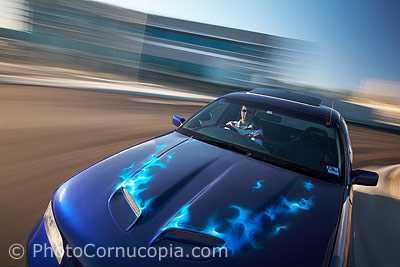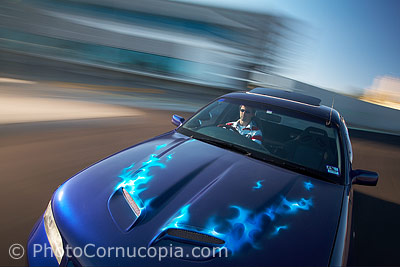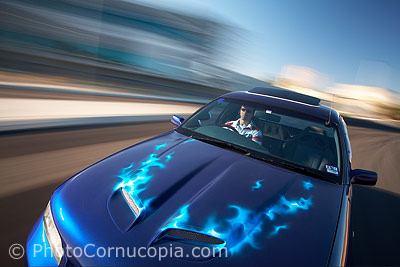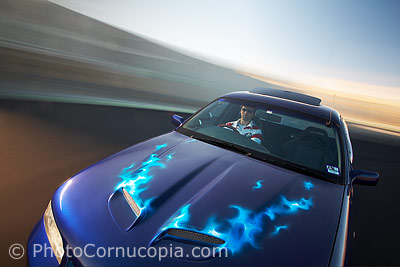|
Topic: |
Rig Shots 9:
Selecting the optimum shutter speed
for rig shots |
|
Author/Copyright: |
John Jovic |
Achieving the
optimum amount of background blur
is the key to making an effective rig shot, assuming of course that a
suitable and interesting composition has been created. If you can get just the right amount of
background blur then you will allow the viewer see the context or story of the
image (assuming the composition allows for this in the first place,
another major failing in most rig shots) whilst still having enough
movement to make the image dramatic. If you go too far, then the entire
background is nothing but blur with very little recognizable detail, no
context, no story, just a car floating in a meaningless background!
There's no such
thing as an optimum shutter speed for a rig shot, just an optimum amount
of background blur, but this will also be subjective to a degree. The optimum amount of background blur varies with
the composition and the effect you are wanting to achieve. Background
blur across approximately 1/8 to 1/3 of the image is commonly quite
effective.
Extending the background blur well beyond those amounts can hide the
background and context of the image resulting in a car kind of floating
in a meaningless blur. Sometimes a 1/2 a second exposure will do the trick, other times 20 or
30 seconds is needed to get the right amount of background movement.
 |
#1
speed: walking pace
exposure:
3 seconds
aperture: F8
filters:
B+W ND 106 + Circular Polarising filter |
 |
#2
speed: walking pace
exposure: 6 seconds
aperture: F6.7
filters:
B+W ND 106 + Circular Polarising filter |
 |
#3
speed: walking pace
exposure:
8 seconds
aperture: F8
filters:
B+W ND 106 + Circular Polarising filter |
 |
#4
speed: walking pace
exposure:
11 seconds
aperture: F9.5
filters:
B+W ND 106 + Circular Polarising filter |
|
The above
examples show the same image at various exposures. There's not much
difference between the 3, 6 and 8 second exposures, possibly due to
small differences in the way the car moved, but the 11 second exposures
are probably too long. |
Background blur
is also determined by the way the car moves during the exposure, not
just the shutter speed. If the car moves in a straight line then the
background may not move very much within the frame, especially where the
camera may be positioned to shoot a dead front/rear or a front/rear 3/4
image. If the steering wheel is turned so that the car moves in a gentle
turn where the camera is on the inside of the circle then the background
blur is greatly accentuated so a/ the car doesn't have to move very much
and b/ a shorter shutter speed can be used to achieve significant
background movement. If you turn the steering wheel so that the camera
is on the outside of the turn then you may find that the background
actually moves very little if the background is close to the centre of
the radius of the turn. Some parts of the background may even appear
stationary if they are in the centre of the turns radius. As long as the
background is some distance from the centre of the turning circle it
will move at an accelerated rate compared to when the car simply
moving in a straight line.



